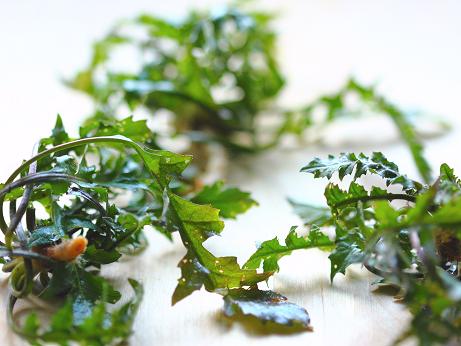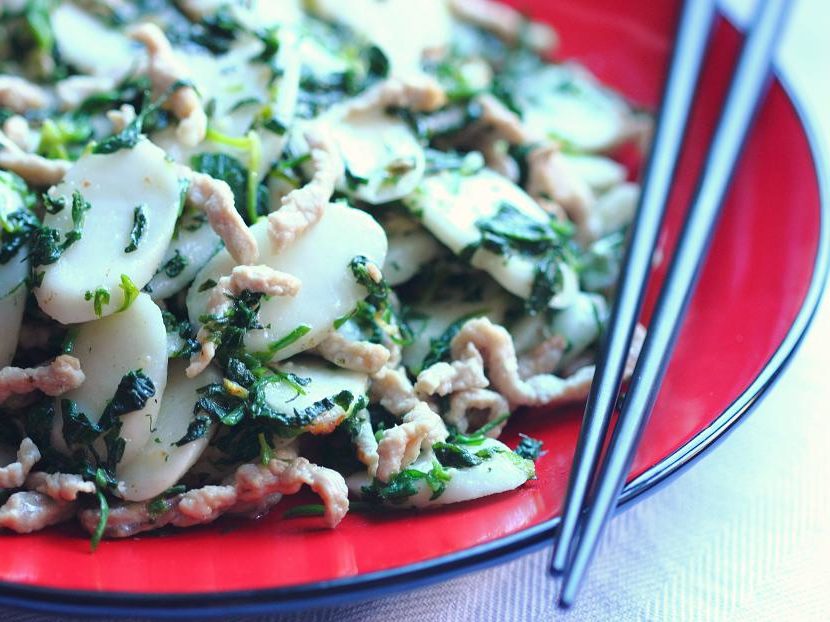Last Updated on October 25, 2020 by Simon Fan
Chinese rice cake, or nian gao (年糕) in Mandarin, literally means “New Year’s cake.” That makes it a perfect food to ring in the new year.
Many varieties of nian gao exist in China and can be used for both savory and sweet dishes. One of my favorite types of niao gao is made with short-grain rice. The process starts with soaking the rice grains for 4 to 7 days, followed by grinding them to a paste with water. After the paste is drained to remove excess water, it is steamed, and then pounded or molded into individual cakes. The reward for all the hard work is superb rice cakes with a unique texture—soft, smooth, and sticky, but at the same time chewy and bouncy. Such nuanced chewiness makes every bite a real pleasure.
Unless your curiosity propels you to make your rice cakes from scratch, you can find good-quality ones at Chinese or Korean grocery stores. For stir-frying, choose the pre-sliced, oval-shaped ones. In Chinese cooking, rice cakes are typically stir-fried with sliced meat (such as pork, Chinese sausage, or chicken) and vegetables (bok choy, spinach, or tatsoi as some examples). They make a very satisfying one-dish meal that you would crave often throughout the year.

The rice cake dish I’m sharing with you here is quite popular in Shanghai and the neighboring region. It calls for shepherd’s purse, known as ji cai (荠菜) in Mandarin. A weed that grows in the wild, shepherd’s purse has a unique aroma that’s earthy and refreshing. It pairs extremely well with meat or tofu, which intensifies its umami flavor. In Shanghai, cultivated ji cai is widely available as well.
In the US, you may occasionally find shepherd’s purse at your local farmers’ market. However, you can get frozen ji cai year-round at the frozen section of Chinese grocery stores. I find the frozen ones retain their original texture and flavor quite well. If ji cai is not available, feel free to substitute spinach in this dish.
Shanghai-style stir-fried rice cakes with pork and shepherd’s purse
Serves 2
Ingredients
5 oz (140 g) pork tenderloin, cut into thin matchsticks about 2 inches (5 cm) long and ¼ inch (6 mm) thick
Marinade
¼ teaspoon grated ginger
½ teaspoon soy sauce
½ teaspoon Shaoxing wine
½ teaspoon potato starch or cornstarch
3 oz (85 g) shepherd’s purse (ji cai 荠菜), fresh or frozen, or substitute spinach
2 tablespoons vegetable oil, divided
8 oz (230 g) sliced rice cakes
Salt and freshly ground white pepper
3 to 4 tablespoons water, plus more as needed
½ teaspoon sesame oil
Directions
- In a bowl, combine the pork with the ingredients for the marinade. Let marinate for 15 minutes.
- If using fresh shepherd’s purse, blanch it briefly in boiling water, then transfer it to a colander and rinse under cold water to cool. Drain well. If using frozen shepherd’s purse, let it thaw completely. Squeeze the blanched or thawed leaves to remove as much water as possible, then cut into ¼-inch (6 mm) pieces.
- Heat 1 tablespoon of the oil in a nonstick pan over medium-high heat. Add the pork and stir-fry until it turns opaque, about 1 minute. Transfer the pork to a plate.
- Add the remaining tablespoon of oil to the pan. Add the rice cakes in a single layer and cook, stirring from time to time, for 1½ minutes. Season lightly with salt and pepper. Gradually add water to the pan, one tablespoon at a time and stirring and mixing until the water is fully absorbed before each addition, until the rice cakes are nicely soft and chewy, about 2 minutes.
- Return the pork to the pan, and mix in the shepherd’s purse. Stir-fry until all the ingredients are well mixed and cooked through, about 1 minute. Adjust the seasoning as needed. Drizzle with the sesame oil and serve.



